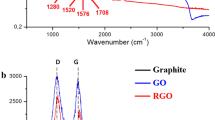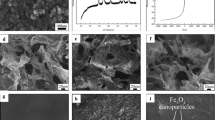Abstract
Superhydrophobic materials have an excellent performance in oil adsorption. In this study, a novel magnetic polydivinylbenzene (PDVB) nanofiber was synthesized by the method of cation polymerization to adsorb oil from water. The magnetic PDVB was hollow nanofiber with Fe3O4 nanoparticles embedded in its structure. The synthesis condition was optimized that the ratio of divinylbenzene (DVB) to boron fluoride ethyl ether (BFEE) was 10:1 (v/v), and the Fe3O4 dosage was 0.175 g/g of DVB. The material showed an excellent oil adsorption performance in wastewater, and the oil concentration could be reduced from 2000 to 92.2 mg/L within 5 min. The magnetic PDVB had relatively high adsorption capacity (12 g/g) for oil, which could be attributed to its super hydrophobicity and one-dimensional nanostructure with high crosslinking degree. The isotherm study indicated that the magnetic PDVB adsorbed oil was an asymmetric or multilayer adsorption process. The material could be regenerated by simple squeeze and maintain its adsorption capacity after it has been used for 10 recycles. In real coking wastewater, the magnetic PDVB kept a good oil adsorption performance without the interference of various pollutants, indicating a wide prospect in practical use.







Similar content being viewed by others
References
Bai YH, Sun QH, Sun RH, Wen DH, Tang XY (2011) Bioaugmentation and adsorption treatment of coking wastewater containing pyridine and quinoline using zeolite-biological aerated filters. Environ Sci Technol 45:1940–1948
Cai Y, Chen D, Li N, Xu Q, Li H, He J, Lu J (2016) A facile method to fabricate a double-layer stainless steel mesh for effective separation of water-in-oil emulsions with high flux. J Mater Chem A 4:18815–18821
Chen HX, Tang HM, Duan M, Liu YG, Liu M, Zhao F (2015) Oil-water separation property of polymer-contained wastewater from polymer-flooding oilfields in Bohai Bay, China. Environ Technol 36:1373–1380
Fard AK, McKay G, Manawi Y, Malaibari Z, Hussien MA (2016) Outstanding adsorption performance of high aspect ratio and super-hydrophobic carbon nanotubes for oil removal. Chemosphere 164:142–155
Gousmi N, Sahmi A, Li HZ, Poncin S, Djebbar R, Bensadok K (2016) Purification and detoxification of petroleum refinery wastewater by electrocoagulation process. Environ Technol 37:2348–2357
Huang X, Peng Y, Pan J, Zhang W, Zhou W, Zhu H, Liu S (2017) Efficient adsorption of oil by hydrophobic macroporous polymer synthesized with the emulsion template and magnetic particles on the surface. J Appl Polym Sci 134:44731
Iftekhar S, Srivastava V, Sillanpaa M (2017) Enrichment of lanthanides in aqueous system by cellulose based silica nanocomposite. Chem Eng J 320:151–159
Jayaramulu K, Geyer F, Petr M, Zboril R, Vollmer D, Fischer RA (2017) Shape controlled hierarchical porous hydrophobic/oleophilic metal-organic nanofibrous gel composites for oil adsorption. Adv Mater 29:1605307
Jiang ZX, Liu Y, Sun XP, Tian FP, Sun FX, Liang CH, You WS, Han CR, Li C (2003) Activated carbons chemically modified by concentrated H2SO4 for the adsorption of the pollutants from wastewater and the dibenzothiophene from fuel oils. Langmuir 19:731–736
Kesharwani T, Valenstein JS, Trewyn BG, Li F, Lin VSY, Larock RC (2010) Synthesis of nanotubes via cationic polymerization of styrene and divinylbenzene. Polym Chem 1:1427–1429
Lalchhingpuii, Tiwari D, Lalhmunsiama, Lee SM (2017) Chitosan templated synthesis of mesoporous silica and its application in the treatment of aqueous solutions contaminated with cadmium(II) and lead(II). Chem Eng J 328:434–444
Lee SY, Park SJ (2013) Hydrogen storage behaviors of Ni-doped graphene oxide/MIL-101 hybrid composites. J Nanosci Nanotechnol 13:443–447
Lin YF, Hsu SH (2017) Solvent-resistant CTAB-modified polymethylsilsesquioxane aerogels for organic solvent and oil adsorption. J Colloid Interface Sci 485:152–158
Liu Q, Shen S, Zhou Z, Tian L (2009) A facile route to synthesis of superparamagnetic Fe3O4–PDVB nanoworms. Mater Lett 63:2625–2627
Liu F, Kong W, Wang L, Noshadi I, Zhang Z, Qi C (2015) Solvothermal synthesis of stable nanoporous polymeric bases-crystalline TiO2 nanocomposites: visible light active and efficient photocatalysts for water treatment. Nanotechnology 26:085705
Lu Y, Yan LH, Wang Y, Zhou SF, Fu JJ, Zhang JF (2009) Biodegradation of phenolic compounds from coking wastewater by immobilized white rot fungus Phanerochaete chrysosporium. J Hazard Mater 165:1091–1097
Minami H, Kojima A, Suzuki T (2017) Preparation of flattened cross-linked hollow particles by suspension polymerization in a solid dispersion medium. Langmuir 33:1541–1546
Ni W, Liang F, Liu J, Qu X, Zhang C, Li J, Wang Q, Yang Z (2011) Polymer nanotubes toward gelating organic chemicals. Chem Commun 47:4727–4729
Ochando-Pulido JM, Martinez-Ferez A (2017) Fouling modelling on a reverse osmosis membrane in the purification of pretreated olive mill wastewater by adapted crossflow blocking mechanisms. J Membr Sci 544:108–118
Patowary M, Ananthakrishnan R, Pathak K (2017) Effective oil removal from water by magnetically driven superhydrophobic and oleophilic magnetic titania nanotubes. Environ Sci Pollut Res 24:18063–18072
Pintor AMA, Vilar VJP, Botelho CMS, Boaventura RAR (2016) Oil and grease removal from wastewaters: sorption treatment as an alternative to state-of-the-art technologies. A critical review. Chem Eng J 297:229–255
Riaz MA, McKay G, Saleem J (2017) 3D graphene-based nanostructured materials as sorbents for cleaning oil spills and for the removal of dyes and miscellaneous pollutants present in water. Environ Sci Pollut Res 24:27731–27745
Rodríguez-Trigo G, Zock JP, Montes II (2007) Health effects of exposure to oil spills. Arch Bronconeumol 43(11):628–635
Salehabadi S, Seyfi J, Hejazi I, Davachi SM, Naeini AH, Khakbaz M (2017) Nanosilica-decorated sponges for efficient oil/water separation: role of nanoparticle’s type and concentration. J Mater Sci 52:7017–7027
Sammarco PW, Kolian SR, Warby RA, Bouldin JL, Subra WA, Porter SA (2013) Distribution and concentrations of petroleum hydrocarbons associated with the BP/deepwater horizon oil spill, Gulf of Mexico. Mar Pollut Bull 73:129–143
Shi XL, Hu XB, Wang Z, Ding LL, Ren HQ (2010) Effect of reflux ratio on COD and nitrogen removals from coke plant wastewaters. Water Sci Technol 61:3017–3025
Song B, Zhu J, Fan H (2017) Magnetic fibrous sorbent for remote and efficient oil adsorption. Mar Pollut Bull 120:159–164
Sun H, Li A, Zhu Z, Liang W, Zhao X, La P, Deng W (2013) Superhydrophobic activated carbon-coated sponges for separation and absorption. Chemsuschem 6:1057–1062
Tran DNH, Kabiri S, Sim TR, Losic D (2015) Selective adsorption of oil-water mixtures using polydimethylsiloxane (PDMS)-graphene sponges. Environ Sci Water Res Technol 1:298–305
Voice TC, Pak D, Zhao X, Shi J, Hickey RF (1992) Biological activated carbon in fluidized bed reactors for the treatment of groundwater contaminated with volatile aromatic hydrocarbons. Water Res 26:1389–1401
Wang X, Xu R, Zhu B, Li Y, Han X (2016) Metal oxide as a template in the preparation of porous poly(2-hydroxyethylmethylacrylate-co-divinylbenzene) particles as a metallocene catalyst support. RSC Adv 6:52464–52474
Wharfe ES, Jarvis RM, Winder CL, Whiteley AS, Goodacre R (2010) Fourier transform infrared spectroscopy as a metabolite fingerprinting tool for monitoring the phenotypic changes in complex bacterial communities capable of degrading phenol. Environ Microbiol 12:3253–3263
Xu N, Wang W, Han P, Lu X (2009) Effects of ultrasound on oily sludge deoiling. J Hazard Mater 171:914–917
Xu ZY, Liu YJ, Chen HB, Yang M, Li HM (2017) Bamboo-like, oxygen-doped carbon tubes with hierarchical pore structure derived from polymer tubes for supercapacitor applications. J Mater Sci 52:7781–7793
Yu L, Zhang S, Zhang M, Chen J (2017) Superhydrophobicity construction with dye-sensitised TiO2 on fabric surface for both oil/water separation and water bulk contaminants purification. Appl Surf Sci 425:46–55
Zhang B, Shi W, Yu S, Zhu Y, Zhanga R, Li L (2015) Optimization of cleaning conditions on a polytetrafluoroethylene (PTFE) microfiltration membrane used in treatment of oil-field wastewater. RSC Adv 5:104960–104971
Funding
This work was supported by the National Natural Science Foundation of China (No. 51308319) and the Fundamental Research Funds for the Central Universities (buctrc201606).
Author information
Authors and Affiliations
Corresponding author
Additional information
Responsible editor: Guilherme L. Dotto
Electronic supplementary material
ESM 1
(DOCX 467 kb)
Rights and permissions
About this article
Cite this article
Zhu, X., Tian, Y., Li, F. et al. Preparation and application of magnetic superhydrophobic polydivinylbenzene nanofibers for oil adsorption in wastewater. Environ Sci Pollut Res 25, 22911–22919 (2018). https://doi.org/10.1007/s11356-018-2385-4
Received:
Accepted:
Published:
Issue Date:
DOI: https://doi.org/10.1007/s11356-018-2385-4




